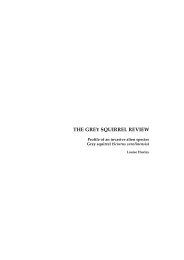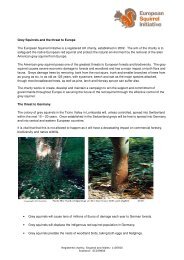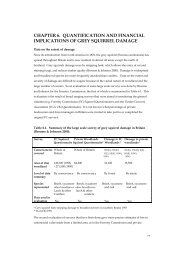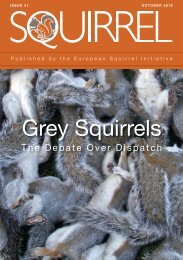grey squirrel trapping advice leaflet - European Squirrel Initiative
grey squirrel trapping advice leaflet - European Squirrel Initiative
grey squirrel trapping advice leaflet - European Squirrel Initiative
- No tags were found...
Create successful ePaper yourself
Turn your PDF publications into a flip-book with our unique Google optimized e-Paper software.
Grey <strong>Squirrel</strong>sTrapping Guidance NotePrepared byThe <strong>European</strong> <strong>Squirrel</strong> InititiveGrey <strong>squirrel</strong>s are an invasive alien species, which werroduced into the UK in 1876and have now spread across most of the country. A destructive pest, they causeserious damage to trees, to song bird populations and our native red <strong>squirrel</strong>.They are attracted to and cause damage to game bird feeders.www.european<strong>squirrel</strong>initiative.org
The LawIt is illegal to release a <strong>grey</strong> <strong>squirrel</strong> back into the wild!Red <strong>Squirrel</strong>s have been protected against intentional acts of damage or disturbance since 1981under the UK Wildlife and Countryside Act (WACA), Schedule 5. Protection for Red <strong>Squirrel</strong>s and otherspecies was amended by the Nature Conservation (Scotland) Act, 2004 to include both intentionaland reckless acts (see FCS guidance note ‘Forest operations and wildlife in Scottish forests’). Subjectto certain exceptions, it is now an offence to ‘intentionally or recklessly: Kill, injure or take (capture) a Red <strong>Squirrel</strong> destroy or obstruct access to any structure or place which a Red <strong>Squirrel</strong> uses forshelter or protection or, a Red <strong>Squirrel</strong> while it is occupying a structure or place which it uses for that purpose.Anyone who carries out, or knowingly causes or permits these acts to occur could be committing anoffence. the Wildlife & Countryside Act 1981 Section 11 and the Wildlife (Northern Ireland)Order 1985 Article 12, if any person uses a decoy, for the purpose of killing or taking any wildmammal, they shall be guilty of an offence the Wild Mammals (Protection) Act 1996 and the Welfare of Animals (Northern Ireland)Act 1972 Article 21, it is illegal to: mutilate, kick, beat, nail, impale, stab, burn, stone, crush,drag, drown or asphyxiate any wild mammal with intent to inflict unnecessary suffering Wild Mammals (Protection) Act 1996 does not apply to lawful pest control or humanedispatch of injured mammals. Unlawful use may include trespassing or acting without theconsent of the landowner Animal Welfare Act 2006 imposes a duty on the trapper not to be cruel to the animal.Control methodsrapping and Warfarin are the most effective methods of controlling <strong>grey</strong> <strong>squirrel</strong>s. rapping canbe done via live capture traps, lethal spring traps and Kania traps. may not be used outdoors where red <strong>squirrel</strong>s occur traps may not be used within 10 kilometres of a red <strong>squirrel</strong> population.Other methods of control include drey poking in <strong>grey</strong> <strong>squirrel</strong> areas only and shooting.
TrappingSuccessful <strong>trapping</strong> can remove up to 90% of the resident <strong>grey</strong> <strong>squirrel</strong>s. must be inspected daily must be anchored capturing non-target species siting traps on or near public footpaths or areas where there may be susceptible wildlifesuch as otters in doubt do not set a lethal trap to be either incinerated, buried deeply or possibly sold to butchers or restaurants. best time for cage <strong>trapping</strong> is between February and August. Spring traps are effectiveall year around.Type of trapsSpring TrapsA spring trap set in a tunnelFenn and Springer traps are set in tunnels. tunnel should be at least 60cm long and itsinterthe traps to strike unobstructed holes at either end of the tunnel shouldbe no more than 8 – 10cm to deter animalslarger than a <strong>squirrel</strong> from entering.Body grip traps and Kania traps may also be used.Cage TrapsCage traps can be used to take any animal which is notprotected. should be inspected at least a once a day animals must be despatched quickly andhumanely non-target species must be released unharmed.Yellow whole maize has proved to be the best all-roundbait. It is cheap, stores well and is very visible to <strong>squirrel</strong>swhen scattered on the ground and up in trees. Uniquely,<strong>grey</strong> and red <strong>squirrel</strong>s only eat the germ of the maize grainand discard the remainderrels havesupplemented with a small quantity of acorns, peanuts orhazelnuts to increase its attraction.Cage trap - courtesy of Mhairi Seymour Photography www.mhairi-seymour.co.uk
A period of pre-baiting is essential to give <strong>squirrel</strong>s a chance to cage traps and become usedto feeding within them. Pre-baiting should last a minimum of 5 days, after which traps should be setfor period of 4 -5 days. Pre-bait a wide area around each trap and then gradually reduce the area, sothat the only maize is in the trap.WarfarinUsing Warfarin in specially design <strong>squirrel</strong> hoppers canremove all <strong>grey</strong> <strong>squirrel</strong>s from a wood if the hopper densityis correct. may only be deployed out of doors against <strong>grey</strong><strong>squirrel</strong>s for tree protection between 15th March and15th August may be poisoned in loft spaces all year round is regulated by the Control of PesticidesRegulation 1986.rey <strong>Squirrel</strong>s (Warfarin) Order 1973 permits the poisoning of <strong>grey</strong> <strong>squirrel</strong>s with Warfarin for thepurpose of tree prrol of Pesticide Regulations 1986 specify on the product label(MAPP no 13020) how, where and when it may be deployed. include bait and thedesign and dimensions of the hopper. Operators must be trained before using Warfarin. It is a criminaloffence to use Warfarin where red <strong>squirrel</strong>s exist.BaitOnly the 0.02% Warfarin bait rey <strong>Squirrel</strong> Bait MAPP no. 13020) may be used. approval forrey <strong>Squirrel</strong> Liquid Concentrate MAFF no. 06455 has been revoked.ropean Standarbe worn when handling the bait and the control operation should be covered by a written RiskAssessment. of contaminated personal protective and other equipment should be through aregistered waste contractor. hoppers should be used which are set to prevent animals larger than <strong>grey</strong> <strong>squirrel</strong>sgaining access to the poison should be spaced approximately 200 metres apart and at a density of one hopper to oneto four hectares depending on density of the <strong>grey</strong> <strong>squirrel</strong> population.Procedure for hoppering prior to 15th March for 10 to 14 days, i.e. at the end of February the whole maize widely and keep the hopper topped up with maize, visit every twoy. Reduce the spread of the broadcast maize over theperiod until only the hopper has the maize the <strong>grey</strong> <strong>squirrel</strong>s are feeding well, usually after 10 -14 days, empty all the maize out into asack and remove frWarfarin bait and keep the hopper topped up 7 -10 days feeding will suddenly stop; this is dependent on the weather hopper, re-site and start the procedure again hoppering is carried out between 15th March and the end of June.Warfarin Hopper - courtesy of Mhairi Seymour Photography www.mhairi-seymour.co.uk
In the interest of funding the research work ofthe <strong>European</strong> <strong>Squirrel</strong> <strong>Initiative</strong>, please completethe following short questionnaire and postback to the address provided.Do <strong>grey</strong> <strong>squirrel</strong>s damage plastic pheasant hoppersor other equipment?What was the estimated cost of such damage last year?Grey <strong>squirrel</strong>s are often attracted to pheasant feed rides where they canbe controlled. Do you find this a useful method to reduce populations?Have you ever witnessed <strong>grey</strong> <strong>squirrel</strong>s predating wild partridge orpheasant eggs/chicks in the last year?How many <strong>grey</strong> <strong>squirrel</strong>s did you kill in 2011?What is the approximate size of the woodland estate?Numbers and sexes in previous years, if known?Are there any red <strong>squirrel</strong>s present in your area?What county are you in?
Please checkthe weight anduse correctpostage stampThe <strong>European</strong> <strong>Squirrel</strong> <strong>Initiative</strong>4 East Bank HouseTide Mill WayWoodbridgeSuffolk IP12 1BYUnited Kingdom
Despatching <strong>squirrel</strong>sShooting at close range through the cage trap with an airgun is a humaneand recommended method of despatch. However blood in the trap maydeter other animals from entering and pose a risk of <strong>squirrel</strong> pox diseasetransfer, particularly where both red and <strong>grey</strong> <strong>squirrel</strong>s are present. method – A medium weight Hessiansack is used to extract the <strong>squirrel</strong>from the trap. Once in the sack the <strong>squirrel</strong> can be moved to a corner andwith the head positioned, killed rapidly and humanely by a single blow to theback of the head with a blunt instrument. <strong>trapping</strong> comb will help you with the removal or dispatch of the <strong>squirrel</strong>;use one or two combs to persuade the <strong>squirrel</strong> to move along the trap.The second comb is placed between comb and the <strong>squirrel</strong> as soonas possible, repeating until the <strong>squirrel</strong> is held at the far end of the trap. Withthe <strong>squirrel</strong> securely trapped you can easily place the Hessian sack over theend of the trap or dispatch with a gun.Disposal of carcassesWhere Warfarin is used carcasses should be disposed of as a controlledrcasses may be left, if believed tobe free from disease and distributed in suitable locations around woodland.Alternatively they may be buried provided they are not diseased or poisoned.If a carcass shows symptoms of <strong>squirrel</strong> pox virus (scabs around eyes,nose, mouth and feet) it should be sent to the State Veterinary Service forinvestigation.Twww.animalhealth.defra.gov.uk
For further information and for a more detailedguidance note on <strong>trapping</strong>,please go towww.european<strong>squirrel</strong>initiative.org.uk<strong>European</strong> <strong>Squirrel</strong> <strong>Initiative</strong>4 East Bank HouseTide Mill WayWoodbridgeSuffolk IP12 1BYUnited Kingdom+44 (0)1394 386919







